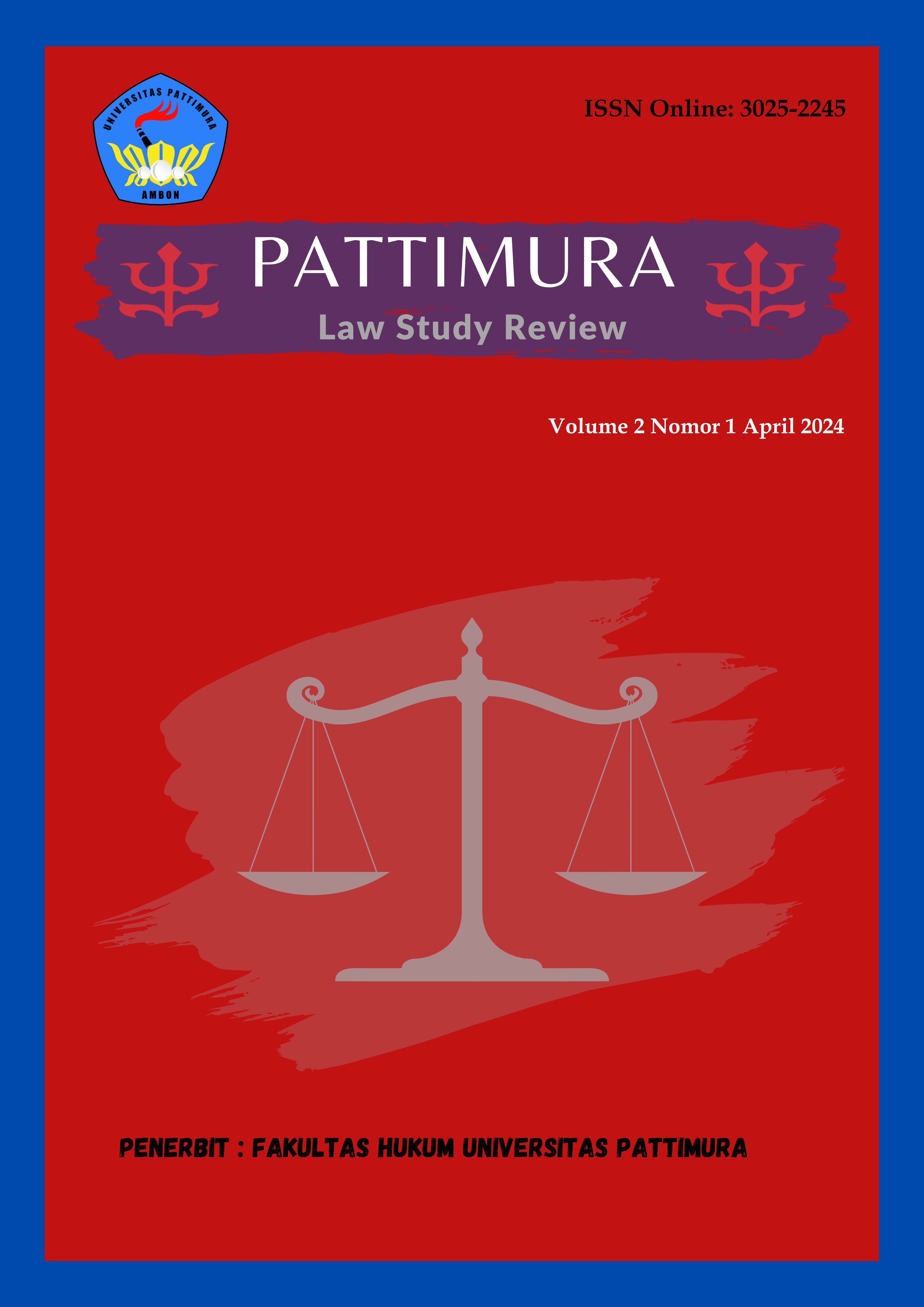Diversi Sebagai Bentuk Penyelesaian Perkara Anak Yang Berhadapan Dengan Hukum (Studi Putusan Perkara Nomor 3/Pid.Sus-Anak/2022/PN Amb)
Abstract
ABSTRACT: Diversion is the transfer of resolution of children's cases from the criminal justice process to a process outside criminal justice. Diversion is carried out at three levels, namely at the investigation, prosecution and court levels. In this case, if the diversion deliberation process is successful, the case will not proceed to the next stage, but if diversion deliberations fail to be carried out at the investigation level, the next effort is to conduct diversion deliberations at the prosecution level. If there is no common ground at the prosecution level, then diversion will be attempted at the court level. The aim of this research is to find out whether the diversion process in this research has fulfilled the principle of legal certainty or not and to find out what factors cause the success of diversion in court. Based on the results of this research, it was concluded that it does not fulfill the principle of legal certainty, because children who make mistakes are not given a deterrent effect by being sentenced to 15 years in prison as regulated in article 81 paragraph (1) and/or paragraph (2) Jo. Article 76D of Law number 35 of 2014 is an amendment to Law 23 of 2002 concerning child protection and the factors causing the success of diversion in court, namely consideration of the customs of Supreme Court Regulation No. 4 of 2014 Article 3.
Downloads
References
Anna Maria Salamor, Astuti Nur Fadillah, Patrick Corputty, Yonna Beatrix Salamor, Child Grooming Sebagai Bentuk Pelecehan Seksual Anak Melalui Aplikasi Permainan Daring, jurnal Terakreditasi Nasional, SK. No. 28/E/KPT/2019, Volume 26 Nomor 4, Oktober - Desember 2020
Hadibah Zachra Wadjo dan Judy Marria Saimima, Perlindungan Hukum Terhadap Korban Kekerasan Seksual Dalam Rangka Mewujudkan Keadilan Restoratif, Jurnal Belo, Fakultas Hukum Universitas Pattimura, Vol. 6, No.1, Agustus 2020 - Januari 2021
Astuti Nur Fadillah, Anna Maria Salamor dan Patrick Corputty, Penyuluhan Hukum Perlindungan Anak Pada Lembaga Kesejahteraan Sosial Anak (LKSA) Ittaqollah Kota Ambon, Aiwadthu: Jurnal Pengabdian Hukum, Vol 1, No. 2, September 2021.
Patrick Corputty dan Astuti Nur Fadillah M, Mewujudkan Kesadaran Hukum Terhadap Kekerasan Dalam Rumah Tangga Bagi Perempuan dan Anak Di Pulau Seram, Communnity Development Journal, Fakultas Hukum, Universitas Pattimura, Vol.2, No. 2 Juni 202.
Patrick Corputty, Deassy Jacomina Anthoneta Hehanussa dan Julianus Edwin Latupeirissa, Victim Precipitation Sebagai Pertimbangan Dalam Penjatuhan Pidana (Kajian Perspektif Sistem Peradilan Pidana), Jurnal Belo, Fakultas Hukum Universitas Pattimura, rissa, rissa, Vol. 7, No. 1, Agustus 2021.
Buku
Abdul Wahid dan Muhammad Irfan, (2001), Perlindungan Terhadap Korban Kekerasan Seksual (Advokasiatas Hak Asasi Perempuan), PT Refika Aditama, Bandung
Aroma Elmina Martha, (2003), Perempuan Kekerasan dan Hukum, UII Press, Yogyakarta
Bambang Waluyo, (2011), “Viktimologi Perlindungan Saksi dan Korban”, Jakarta, Sinar Grafika
Esthi Susanti Hudiono, (2014), Perlindungan Anak dari Eksploitasi Seksual Sebuah Prespektif OrganisasiMasyarakat Sipil, Aswaja Pressindo, Yogyakarta
Johnny Ibrahim, (2013), Teori dan Metodologi Penelitian Hukum Normatif, Bayu Media, Malang
Koesnan, R.A, (2005), Susunan Pidana dalam Negara Sosialis Indonesia, Sumur, Bandung
Marlina, (2010), Pengantar Konsep Diversi dan Resotative Justice (Medan: USU Press).
Maidin Gultom, (2013) Perlindungan Hukum Terhadap Anak-Anak, Bandung
Mukti Fajar dan Yulianto Achmad, (2017), Dualisme Penelitian Hukum Normatif dan Empiris, Cetakan IV, Pustaka Pelajar, Yogyakarta
Lain-Lain
https://indonesiabaik.id/motion_grafis/diversi-dalam-sistem-peradilan-pidana-anak
MaPPIFHUI. (2018). Apa sih perbedaan Kekerasan Seksual & Pelecehan Seksual? Mappifhui.Org. http://mappifhui.org/2018/10/30/serba-serbi- kekerasan-seksual-terhadap-perempuan/
Copyright (c) 2024 Honney Uplera Latekay, Hadibah Zachra Wadjo, Patrick Corputty (Author)

This work is licensed under a Creative Commons Attribution-NonCommercial 4.0 International License.
Authors who publish their manuscripts in this Journal agree to the following conditions:
- The copyright in each article belongs to the author, as well as the right to patent.
- Authors are able to enter into separate, additional contractual arrangements for the non-exclusive distribution of the journal's published version of the work (e.g., post it to an institutional repository or publish it in a book), with an acknowledgment of its initial publication in this journal.
- Authors are permitted and encouraged to post their work online (e.g., in institutional repositories or on their website) prior to and during the submission process, as it can lead to productive exchanges, as well as earlier and greater citation of published work.
- Authors have the right to self-archiving of the article (Author Self-Archiving Policy)













